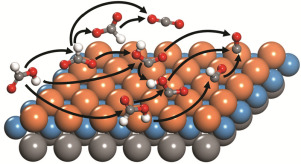当前位置:
X-MOL 学术
›
Chin. J. Catal.
›
论文详情
Our official English website, www.x-mol.net, welcomes your feedback! (Note: you will need to create a separate account there.)
Unveiling the decomposition mechanism of formic acid on Pd/WC(0001) surface by using density function theory
Chinese Journal of Catalysis ( IF 16.5 ) Pub Date : 2020-03-01 , DOI: 10.1016/s1872-2067(19)63463-7 Jinhua Zhang , Yuanbin She
Chinese Journal of Catalysis ( IF 16.5 ) Pub Date : 2020-03-01 , DOI: 10.1016/s1872-2067(19)63463-7 Jinhua Zhang , Yuanbin She

|
Abstract In pursuit of low-cost direct formic acid fuel cells, tungsten carbide (WC) supported Pd catalyst is considered as an ideal candidate for efficient decomposition of formic acid due to low Pd utilization and excellent performance. Herein, different adsorption configurations and active sites of the intermediates, involved in the HCOOH decomposition, on WC(0001)-supported Pd monolayer (Pd/WC(0001)) surface investigated by using density functional theory. The results reveal that trans-HCOOH, HCOO, cis-COOH, trans-COOH, HCO, CO, H2O, OH and H exhibit chemisorption on Pd/WC(0001) surface, whereas cis-HCOOH and CO2 exhibit weak interactions with Pd/WC(0001) surface. In addition, the minimum energy pathways of HCOOH decomposition are analyzed to generate CO and CO2 due to the fracture of C–H, H–O and C–O bonds. The adsorbed HCOOH, HCOO, mHCOO, cis-COOH and trans-COOH configurations exhibit dissociation rather than desorption. CO formation occurs through the decomposition of cis-COOH, trans-COOH and HCO, whereas the CO2 formation happens due to the decomposition of HCOO. It is found that the most favorable pathway for HCOOH decomposition on Pd/WC(0001) surface is HCOOH→HCOO→CO2, where the formation of CO2 from HCOO dehydrogenation determines the reaction rate. Overall, CO2 is the most dominant product of HCOOH decomposition on Pd/WC(0001) surface. The presence of WC, as monolayer Pd carrier, does not alter the catalytic behavior of Pd and significantly reduces the Pd utilization.
中文翻译:

用密度函数理论揭示甲酸在 Pd/WC(0001) 表面的分解机制
摘要 在追求低成本直接甲酸燃料电池的过程中,碳化钨 (WC) 负载的 Pd 催化剂由于 Pd 利用率低和优异的性能而被认为是高效分解甲酸的理想候选者。在此,使用密度泛函理论研究了 WC(0001) 负载的 Pd 单层 (Pd/WC(0001)) 表面上参与 HCOOH 分解的中间体的不同吸附构型和活性位点。结果表明,trans-HCOOH、HCOO、cis-COOH、trans-COOH、HCO、CO、H2O、OH 和 H 在 Pd/WC(0001) 表面表现出化学吸附,而 cis-HCOOH 和 CO2 与 Pd/ WC(0001) 表面。此外,分析了由于 C-H、H-O 和 C-O 键断裂而产生 CO 和 CO2 的 HCOOH 分解的最小能量途径。吸附的 HCOOH、HCOO、mHCOO、顺式-COOH 和反式-COOH 构型表现出解离而不是解吸。CO 的形成是通过顺式 COOH、反式 COOH 和 HCO 的分解而发生的,而 CO2 的形成是由于 HCOO 的分解而发生的。发现HCOOH在Pd/WC(0001)表面分解的最有利途径是HCOOH→HCOO→CO2,其中HCOO脱氢生成CO2决定了反应速率。总体而言,CO2 是 Pd/WC(0001) 表面 HCOOH 分解的最主要产物。WC 作为单层 Pd 载体的存在不会改变 Pd 的催化行为并显着降低 Pd 的利用率。而 CO2 的形成是由于 HCOO 的分解。发现HCOOH在Pd/WC(0001)表面分解的最有利途径是HCOOH→HCOO→CO2,其中HCOO脱氢生成CO2决定了反应速率。总体而言,CO2 是 Pd/WC(0001) 表面 HCOOH 分解的最主要产物。WC 作为单层 Pd 载体的存在不会改变 Pd 的催化行为并显着降低 Pd 的利用率。而 CO2 的形成是由于 HCOO 的分解。发现HCOOH在Pd/WC(0001)表面分解的最有利途径是HCOOH→HCOO→CO2,其中HCOO脱氢生成CO2决定了反应速率。总体而言,CO2 是 Pd/WC(0001) 表面 HCOOH 分解的最主要产物。WC 作为单层 Pd 载体的存在不会改变 Pd 的催化行为并显着降低 Pd 的利用率。
更新日期:2020-03-01
中文翻译:

用密度函数理论揭示甲酸在 Pd/WC(0001) 表面的分解机制
摘要 在追求低成本直接甲酸燃料电池的过程中,碳化钨 (WC) 负载的 Pd 催化剂由于 Pd 利用率低和优异的性能而被认为是高效分解甲酸的理想候选者。在此,使用密度泛函理论研究了 WC(0001) 负载的 Pd 单层 (Pd/WC(0001)) 表面上参与 HCOOH 分解的中间体的不同吸附构型和活性位点。结果表明,trans-HCOOH、HCOO、cis-COOH、trans-COOH、HCO、CO、H2O、OH 和 H 在 Pd/WC(0001) 表面表现出化学吸附,而 cis-HCOOH 和 CO2 与 Pd/ WC(0001) 表面。此外,分析了由于 C-H、H-O 和 C-O 键断裂而产生 CO 和 CO2 的 HCOOH 分解的最小能量途径。吸附的 HCOOH、HCOO、mHCOO、顺式-COOH 和反式-COOH 构型表现出解离而不是解吸。CO 的形成是通过顺式 COOH、反式 COOH 和 HCO 的分解而发生的,而 CO2 的形成是由于 HCOO 的分解而发生的。发现HCOOH在Pd/WC(0001)表面分解的最有利途径是HCOOH→HCOO→CO2,其中HCOO脱氢生成CO2决定了反应速率。总体而言,CO2 是 Pd/WC(0001) 表面 HCOOH 分解的最主要产物。WC 作为单层 Pd 载体的存在不会改变 Pd 的催化行为并显着降低 Pd 的利用率。而 CO2 的形成是由于 HCOO 的分解。发现HCOOH在Pd/WC(0001)表面分解的最有利途径是HCOOH→HCOO→CO2,其中HCOO脱氢生成CO2决定了反应速率。总体而言,CO2 是 Pd/WC(0001) 表面 HCOOH 分解的最主要产物。WC 作为单层 Pd 载体的存在不会改变 Pd 的催化行为并显着降低 Pd 的利用率。而 CO2 的形成是由于 HCOO 的分解。发现HCOOH在Pd/WC(0001)表面分解的最有利途径是HCOOH→HCOO→CO2,其中HCOO脱氢生成CO2决定了反应速率。总体而言,CO2 是 Pd/WC(0001) 表面 HCOOH 分解的最主要产物。WC 作为单层 Pd 载体的存在不会改变 Pd 的催化行为并显着降低 Pd 的利用率。



























 京公网安备 11010802027423号
京公网安备 11010802027423号